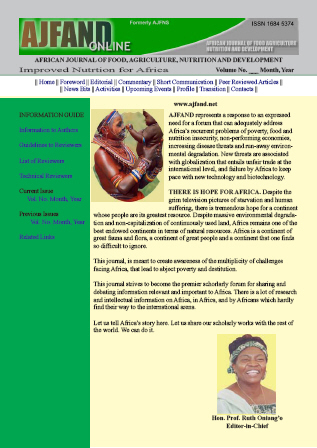
|
African Journal of Food, Agriculture, Nutrition and Development
Rural Outreach Program
ISSN: 1684-5358
EISSN: 1684-5358
Vol. 9, No. 4, 2009, pp. 1110-1128
|
 Bioline Code: nd09048
Bioline Code: nd09048
Full paper language: English
Document type: Research Article
Document available free of charge
|
|
|
African Journal of Food, Agriculture, Nutrition and Development, Vol. 9, No. 4, 2009, pp. 1110-1128
| en |
Efficacy Of Traditional Maize ( Zea mays  L.) Seed Storage Methods In Western Kenya L.) Seed Storage Methods In Western Kenya
Wambugu, P.W.; Mathenge, P.W.; Auma, E.O. & van Rheenen, H.A.
Abstract
Seed security is key to the attainment of household food security among resource poor
farmers in developing countries. In a baseline survey carried out in Siaya and Busia
Districts of Western Kenya, storage was identified as a priority problem facing onfarm
seed production. During the survey, it was found that about 80% of the farmers
produce and store their own seeds for planting in the next cropping season. During
this process of seed saving, farmers reported some decline in seed quality thus leading
to poor germination and eventually poor yields. A storage experiment was, therefore,
set up with the objective of improving the efficacy of traditional maize seed storage
methods in maintaining seed viability and vigour as compared to some improved
ones. The traditional methods included hanging cobs over the fireplace and storing in
gunny bags with cow dung ash as the seed treatment. These were compared with seed
treatment using Mortein Doom®, a modern seed protectant and cow dung ash; in both
cases seeds were stored in airtight containers. These treatments were applied on two
maize varieties: Rachar, a local variety and Maseno Double Cobber, an improved
variety and the experiment was carried out in the houses of four farmers. Quality
analysis of the seeds was done first before storage and then after three and six months
of storage. The results indicate that the traditional methods had the poorest
performance. They had significantly lower vigour after three and six months' storage
and recorded significantly higher insect damage. Seeds hung above the fireplace had
the highest insect damage and this was about 99% higher than the damage recorded
for seeds treated with ash and stored in airtight plastic containers. Seeds hung above
the fireplace also had significantly higher moisture content increase. The best
treatment was storage in airtight containers with either Mortein Doom® or cow dung
ash as the seed treatment. Genetic differences in storability between the 2 varieties
were not observed. This study concluded that the principle of airtight, though not new,
should be used to design low cost seed storage containers for resource-poor farmers
which will result in better seed quality. The study further shows that cow dung which
is freely available in most homesteads is a good seed protectant and is effective in
maintaining seed quality in storage. Cow dung ash should therefore be combined with
air tight storage to increase the seed longevity.
Keywords
Cow dung, airtight, seed, viability
|
| |
© Copyright 2009 - Rural Outreach Program
Alternative site location: http://www.ajfand.net/
|
|
